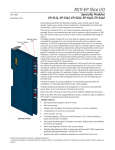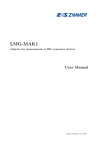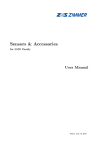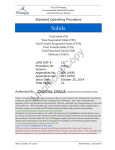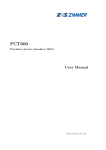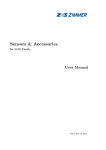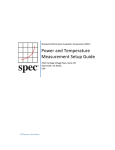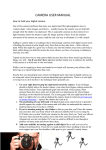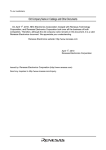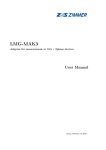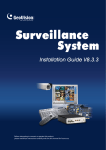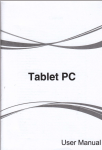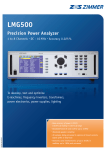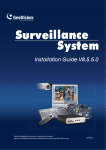Download Brochure LMG95
Transcript
Precision Power Meter LMG95 The most precise in its class. LMG95 e 03.11 • • • • Basic accuracy 0.015% of reading + 0.01% of range Precision range DC...500kHz Analysis of devices and components in switched or modulated operation Harmonics and flicker according to EN61000-3-2/-3/-11/-12 LMG95. Precise. Direct. All Waveforms. The LMG95 single-phase precision power meter is an outstanding product in the proven LMG series of ZES ZIMMER® precision power measuring devices. Highly accurate continuously gapless signal measurement and processing, ergonomic operation and presentation of the results, interfaces with high data rates for efficient system applications – these are the performance features which distinguish the LMG95. Charging current of a switching power supply All Waveforms The high precision power measurements on components and devices that are required in development, quality assurance and manufacturing can be performed with ease, independent of whether the current and voltage are sinusoidal or distorted, whether the load is linear or not, or whether the circuit works in a chopped, pulsed or another modulation mode. The extended possibilities of synchronization on the periodicity of the measured signal always produce distinct and stable measurement displays and results. Waveform of charging current Amplitude spectrum of the current harmonics with CE evaluation in accordance with class A Direct up to 600V and 20A Isolated measurement inputs with direct measurement ranges up to 600V (1600Vpeak) and 20A (960Apeak for the measurement of inrush currents) and the input for current measurements using a shunt or other transducer measure the incoming measurement signals exactly and without any aberrations. Phase-angle control 0.015% of Reading + 0.01% of Range With a basic accuracy of 0.025% is this the most precise instrument in its class and therefore it is used as a reference device for energy meters, power meters, power measurement transformers and trms meters for current and voltage. Waveform of current Harmonics and Flicker in Full Compliance with EN61000-3-2/-3/-11/-12 The harmonic analysis in full compliance with the EN61000-3-2/-12 standard is already available in the basic unit. The flicker meter in compliance with EN61000-4-15 for the measurement of flicker (voltage variations) and with EN61000-3-3/-11 is available as an option. These two functions also considerably extend the possible applications of the LMG95 in R&D laboratories. If suitable stable voltage sources are available, tests for CE compliance can be performed in accordance with EN61000-3-2/-3/-11/-12. Table of the current harmonics with limits in accordance with class A PWM frequency inverter Analyzers in CE Test Systems The LMG95 is used as an analyzer in CE test systems to test electrical devices on harmonics and flicker and their effect on mains. The ZES ZIMMER® test system CE-Test61k is usually equipped with a precision power meter LMG500 for 3-phase application or with a LMG95 for singlephase applications. Components can also be ordered and used separately, easy integration of customer owned power sources. Line voltage against artificial midpoint Measurement of the amplitude spectrum of the voltage harmonics in the HRM100 mode. An increase in the 47th and 49th, the frequency of the fundamental amounts to fn/47=26.25Hz Transparency Through Real-time Visualization in the Time and Frequency Range. Electronic transformer Electronic 12V transformer to supply a halogen lamp. Amplitude modulated 150 kHz carrier with 100Hz envelope. Burst firing control of a hot-air fan Harmonic analysis Amplitude spectrum with the help of the HRM100 harmonic analysis. The burst fire presents a 1.56Hz modulation of the carrier (50Hz mains voltage). The DC component of the spectrum results from the blower motor in half-wave operation. The extended “X-Trig” trigger mode detects the 1.56Hz periodicity which is used for synchronization. Flicker measurement Using the plot function, the half-wave trms values Ul are plotted over time (lower curve B). There are irregular sags of about 8V. The momentary flicker Pmom resulting from these changes is visualized by curve A. Switch-on current of a fluorescent lamp ballast measured in the transient mode Switch-on current of a fluorescent lamp ballast. The iron is not saturated. Inrush current of a transformer In the moment when the currentless, non-magnetized transformer is switched on, a multiple of the nominal current is required to build up the necessary flux. The iron goes rapidly into saturation. Here Iinr/Itrms=12.9. Formula Editor, Device Settings and Fast Analog Outputs. Core losses at small cos ϕ and high frequencies (with optional 500kHz precision bandwidth and delay compensation to 4ns) I ˜ U The magnetizing current I flowing in the primary winding is fed into the current input of the LMG95, and the induced voltage at the open secondary winding is fed into the voltage input. In this way, only the core losses (magnetizing losses) are measured, and not the copper losses. The half-wave rectified voltage value, also measured with the LMG95, is a measure of the voltage time area, and therewith for the induced flux. With the formula editor, the values for a B-H characteristic curve can be calculated from the measured electrical values and the geometrical data of the core. Device settings Up to 8 device settings can be stored with a name, details of the EUT etc. with “Save” and retrieved again with “Recll”. This provides for a high level of user convenience if measurements are made alternatively on different EUTs. Fast analog outputs u(t), i(t), p(t) for HIL (hardware-in-the-loop) control LMG95 Ext. Shunt I Input I* u(t), i(t), p(t) U U* ~ EUT / Simulation Output The instantaneous values of u(t), i(t), p(t) can be output with a sample rate of 100kSample/s. Via the process signal interface the values can be send to the EUT or a simulation for testing the dynamic control. Fast HIL controls require the instantaneous values rather than values that are delayed and averaged over the measuring cycle (≥ 50ms). Energy Efficiency EU energy label Since 1988 household appliances like refrigerators or washing machines must be labeled with the EU energy label (see picture). The green range ‘A’ indicates the most efficient energy utilization, the opposite is true for the red range ‘G’. Precise power meters like the LMG95 are indispensable for the validation of the chosen label by independent test laboratories. Energy Star The Energy Star originally started in Northern America and has spread all over the world. For being marked with the Energy Star, a product has to meet a defined threshold. For example, in the USA a newly introduced refrigerator has to save 20% relative to the current maximum admissable consumption. A precise power meter is necessary for both the R&D of a new product and tests in the field whether it meets the specified savings. Energy Efficiency EuP - Energy using Products The directive 2005/32/EC defines ecodesign requirements for household appliances and office machines. It regulates the admissible energy consumption while a product is in use as well as the energy consumption during its fabrication and its disposal. In addition, the directive addresses further ecological aspects like saving resources through an economic material usage and avoiding hazardous substances. Green IT To save the environment, information technology and communications equipment has to economize on energy and resources throughout its life cycle. To meet these requirements, it is important to optimize the equipment during the development stage. For this purpose, the precision power meter LMG95 is a helpful tool for every R&D engineer. SPECpower_ssj2008 The Standard Performance Evaluation Corporation (SPEC) is a working group of well-known manufacturers of computer systems. SPEC has created the industry standard SPECpower_ssj2008. This is a method for measuring computing power, electrical power consumption and energy efficiency. The abbreviation ssj (server side JAVA) refers to the workload on the server which is reduced in steps of 10% starting at 100% (full utilization) to zero (no load) (see picture). SPECpower_ssj2008 requires that a power meter records the power consumption with a time resolution of 1 second and logs the data into a control system. ZES ZIMMER® power meters (LMG95 for single-phase, LMG450 and LMG500 for multi-phase applications) meet this standard. Due to their range dynamic, they are able to precisely capture changes of the load, e.g. when changing to another workload. Moreover, they do not only transmit the measuring value, but also the respective measuring range and its utilization, so that the measuring uncertainty can be calculated for each period. ZES ZIMMER® LMG-series power meters have been approved by SPEC. Source: © 2007-2009 Standard Performance Evaluation Corporation (SPEC), reprint with permission. Source: Article „The measurement of the PC world“, c‘t 2008, edition 4. Standby Power Measurement The regulation 1275/2008 released by the European Commission defines limits for power consumption of household appliances for the „off“-mode and a defined standby mode. From January 2010 these limits are 1W respectively 2W, and from 2014 the limits will be cut to half to 0.5W respectively 1W. In case of an ohmic load a voltage of 230V and an acceptable power loss of 0.5W implies a current of about 2.2mA. 2% accuracy of 0.5W equals an uncertainty of 10mW, which seems to be easy to handle by most power meters. However, in practice standby circuits usually have a low power factor and a high crest factor. Assuming that the power factor is 0.1, which is rather common for applications like refrigerators or PC monitors, the current is 10 times larger than in the example above, and hence the measuring range also needs to be increased by this factor. The crest factor of a state-of-the-art „zero-watt PC“ can reach values of 6 or higher due to its rectifier with smoothing capacitor. These peaks superimpose the capacitive reactance current and yield the main contribution to the standby consumption, and therefore the measuring range has to be increased by an additional factor. In this example, the measuring range must measure a current of 22mA, with a peak value of 130mA. The low power factor and the high crest factor can increase the measuring uncertainty by the order of two, and hence the power meter must have a basic accuracy of 0.03%. Energy Efficiency The LMG95 meets these high-end requirements. LMG95 Ext. Shunt I Input I* To optimize the scaling and to protect the unit, use an additional external shunt (L95-SH-xxx-P). For low currents, use the wiring for current-correct measurement. (See also into our application note #102 “Measurement of Standby Power and Energy Efficiency”.) U U* Ext. Shunt LMG-SHxxx-P L AC Power Supply 230V N The ZES ZIMMER software CE-Test-Standby in combination with a precision power meter LMG95 or LMG500 measures the standby consumption according to the standard IEC/EN 62301. CE-Test-Standby configures and monitors the measuring devices, sets the test sequence and generates a test protocol in accordance with the standard. EUT PE Current-correct measurement with external shunt LMG-SHxxx-P Technical Data Voltage measuring ranges Rated range value /V Permissible trms value /V Permissible peak value for full scale /V Overload capability Input resistance 6 7.2 12.5 12.5 14.4 25 25 30 50 60 60 100 130 130 200 250 270 400 400 560 800 600 720 1600 0.15 0.3 0.6 1.2 0.3 0.6 1.3 2.6 0.469 0.938 1.875 3.75 2.5 5.2 7.5 5 10 15 10 21 30 20 21 60 Options for modification of 600V-standard-measuring input: Options: Measuring ranges: L95-07-2 25mV...3V L95-07-3 100mV...12V L95-07-4 400mV...60V L95-07-5 12V...650V (3200Vpk) 1500V for 1s 1MΩ, 20pF Current measuring ranges Rated range value /A Permissible trms value /A Permissible peak value for full scale /A Overload capability Input resistance 120 21 120 240 21 240 480 21 480 960 21 960 Options for modification of 20A-standard-measuring input: Options: Measuring ranges: L95-08-1 0.6mA...80mA L95-08-2 10mA...1.2A L95-08-3 40mA...5A 160A for 1s 5mΩ Voltage inputs for current measuring with shunt / transducer Rated range value /V Permissible trms value /V Permissible peak value for full scale /V Overload capability Input resistance 0.03 0.06 0.0977 0.06 0.13 0.1953 0.12 0.27 0.3906 0.25 0.54 0.7813 0.5 1 1.563 1 2 3.125 2 4 6.25 4 8 12.5 250V for 1s 100kΩ Measuring range selection Auto, manual or remote control Isolation Current and voltage path are isolated against each other and may float against earth with 1000V/CAT III Measuring method Simultaneous sampling of the current and voltage inputs and A/D conversion of the instantaneous values (100kHz). Memory for up to 2.106 sampling values Measuring cycle, synchronization, averaging For measurements of the trms values for current, voltage and active power, the measuring cycle time is adjustable in the range from 50ms to 60s. In each measuring cycle gapless 100kHz sampling and evaluation. The synchronization can be performed on the measuring signal, the fundamental harmonic, the envelope, the mains or an external signal. Averaging over 1 to 1000 measuring cycles Measuring uncertainty (Standard version) ± (% of measuring value + % measuring range) Measuring uncertainty DC 0.05...15Hz 15...45Hz 45...65Hz 65Hz...1kHz 1...3kHz 3...15kHz 15...50kHz Voltage 0.02+0.06 0.02+0.04 0.015+0.03 0.01+0.02 0.015+0.03 0.03+0.06 0.1+0.2 0.5+1.0 Current 0.02+0.06 0.02+0.04 0.015+0.03 0.01+0.02 0.015+0.03 0.03+0.06 0.1+0.2 0.5+1.0 Shunt voltage input 0.02+0.06 0.02+0.04 0.015+0.03 0.01+0.02 0.015+0.03 0.03+0.06 0.1+0.2 0.5+1.0 Active power 0.03+0.06 0.035+0.04 0.025+0.03 0.015+0.01 0.025+0.03 0.05+0.06 0.2+0.2 1.0+1.0 Measuring uncertainty (500kHz version, Option L95-O6-1) ± (% of measuring value + % measuring range) Measuring uncertainty DC 0.05...15Hz 15...45Hz 45...65Hz 65Hz...1kHz 1...3kHz 3...15kHz 15...100kHz 100...200kHz 200...300kHz 300...400kHz 400...500kHz Voltage 0.02+0.06 0.02+0.04 0.015+0.03 0.01+0.02 0.015+0.03 0.025+0.05 0.03+0.06 0.1+0.2 0.5+1.0 1.0+2.0 3.0+3.0 4.0+4.0 Current 0.02+0.06 0.02+0.04 0.015+0.03 0.01+0.02 0.015+0.03 0.025+0.05 0.03+0.06 0.1+0.2 0.5+1.0 1.0+2.0 3.0+3.0 4.0+4.0 Shunt voltage input 0.02+0.06 0.02+0.04 0.015+0.03 0.01+0.02 0.015+0.03 0.025+0.05 0.03+0.06 0.1+0.2 0.5+1.0 1.0+2.0 3.0+3.0 4.0+4.0 Active power 0.03+0.06 0.035+0.04 0.025+0.03 0.015+0.01 0.025+0.03 0.04+0.05 0.05+0.06 0.2+0.2 1.0+1.0 2.0+2.0 6.0+3.0 7.0+4.0 Technical Data Measuring uncertainty of cos ϕ Measuring uncertainties based on: Other values 1. sinusoidal voltage and current 2. ambient temperature 23 ± 3°C 3. warm up time 1h 4. 5. definition of power range as the product of current and voltage range, 0 ≤ IλI ≤ 1, λ = P/S (power factor) calibration interval 12 months All other values are derived from the values for current, voltage and active power. Accuracies for the derived values depend on the functional relation (e.g. S = I * U, ∆S/S = ∆I/I + ∆U/U) Internal time base ±100ppm Frequency measuring 0.05Hz...500kHz ±0.01% of measuring value, measuring channel selectable Display of measured and computed values Representation With standard abbreviation of measured magnitudes, numeral values 6 digits (0...999999), with sign, decimal point and unit (e.g. Itrms 0.73851mA), 4 to 8 values can be displayed simultaneously, selectable via default or user defined menus Voltage, current Trms value, peak values (min, max, pp), rectified value (rect), mean value (dc), trms value of ac component (ac), form factor, crest factor Power Active power (P), reactive power (Q), apparent power (S), phase angle (ϕ), power factor (λ) Impedance Amount (Z), real and imaginary part of resistor in serial equivalent circuit Integrated values depending on the measuring time Energy, charge Date and time, measuring time Adjustable parameters The integration can be controlled manually, automatically using start and stop times, via external trigger or remote controlled via computer interface Active energy (Ep), reactive energy (Eq), apparent energy (Es), charge (q) Current date (day, month, year) with time (hours, minutes, seconds), accu buffered real time clock, start time for measurement, running measuring time, on-time, each with days, hours, minutes, seconds Scaling factors for external shunt, current and voltage transducer Synchronization Synchronization is made on the periodicity of the measured signal. Periodicity can be determined by the signals u(t), i(t), p(t), u²(t), i²(t), each of them can be adapted with selectable filters. By this stable displays also with pulse width modulated signals (e.g. frequency inverter) and amplitude modulated signals (e.g. electronic ballast). Synchronization also by „Line“ and „External“ Scope function Graphical representation of sampled values (waveform of the signal) Plot function Time diagram of calculated values, e.g. trms value and power Harmonic analysis CE-Hrm Analysis of current and voltage up to the 40th harmonic (total of 41 with DC component), fundamental in the range 45Hz to 65Hz. Analyzer in accordance with EN61000-4-7 with evaluation in full compliance with EN61000-3-2/-12 Harmonic analysis HRM100 (Option L95-O10) Analysis of current, voltage and active power up to the 99th harmonic (total of 100 with DC component, max. 10/50kHz), fundamental in the range 0.1 Hz to 1.2 kHz; with adjustable divider (1...50), a new fundamental can be set as a reference, for example to determine interharmonics Flicker measuring (Option L95-O4) Flicker meter in accordance with EN61000-4-15 with evaluation in accordance with EN61000-3-3/-11 Memory extension (Option L95-O11) Memory extension for scope function up to 4 million samples of U, I and P. Sample values available via interface Transients – monitoring and storing (Option L95-O5) Storing and graphical displaying of transients with a resolution of 10µs, memory extension (L95-O11) is included. Storing depth is 4 Millions sample values, selectable recording duration from 0.05 to 60 seconds. Adjustable pre-trigger, different possibilities of triggering Computer interface (Option L95-O1) Remote control Output data Transfer rates Interfaces: RS232 and IEEE488.2, only one interface can be used at the same time All functions can be remote controlled Output of all displayable data possible, data formats of all interfaces are the same, SCPI command set RS232: max. 115200 Baud, IEEE488.2: max. 1MByte/sec Printer interface (included in Option L95-O1) Parallel PC-printer interface with 25 pin SUB-D socket for printing of values, tables and graphics Processing signal interface (Option L95-O3) 25 pin SUB-D socket: 4 analog inputs for registration of auxiliary quantities (16bit, ±10V) 4 analog ouputs (16bit, ±10V) for output of: • various measure values and operands; updated at the end of each measuring cycle • signal samples (i,u,p), synchronous to the 100kHz sampling frequency 4 digital inputs for registration of status 4 digital outputs to signal states and alarms 1 input for frequency (0.1Hz...500kHz) and direction (e.g. of motors) 1 power supply output 12V/50mA Inputs and outputs are isolated group wise against each other and against the other electronics (testing voltage 500V) Other data External synchronization/trigger Isolated interface for external control of measurement cycle and integration times, outputs for status signals about the actual measuring Service RS232 interface For installing options, firmware and for instrument diagnosis Auxiliary power supply output +15V/0.4A and -15V/0.2A for external transducers Dimensions/weight Desktop case, (w)320mm x (h)147mm x (d)274mm, subrack 84PU, 3HU, (d)274mm, about 5.5kg Safety regulation EN61010-1, protection class I, overvoltage class III Electromagnetic compatibilty EN61326-1, EN61000-3-2, EN61000-3-3 Protection class IP20 acc. to EN60529 Operation temperature, storage temperature 5...40°C, -20...+55°C Supply 90...250V, 45...65Hz, about 30W Measurement Accesories and Extensions „Plug N‘Measure“ current sensors for extended current ranges up to 10000A Precision DC Precision AC Clamp on CT Wideband AC Low-cost Hall Shunt for standby measurements 0.02% 0.02% 0.15% 0.25% 0.3% 0.15% DC...1MHz 15Hz...5kHz 2Hz...50kHz 30Hz...1MHz DC...200kHz DC...100kHz 0.8A...5000A 5A...10000A 0.3A...3000A 10A...1000A 0.3A...2000A 0.15mA...1A HF-differential transformer with load resistor for almost reactionless measurement of current, e.g. at discharge lamps. Technical data, information and selection guide in the user manual „ZES Sensors and Accessories“ (available on request and at www.zes.com). Precision high voltage divider Precision high voltage divider for 3/6/9/12/30kV up to 300kHz, 0.05%. Negligible phase error, therefore best suited for wideband power measuring. - 1-channel HST for single ended voltages - 2-channel HST for floating voltages (difference measuring) - 3-channel HST for three phases systems (inverters) Power quality analysis in railway technology and medium-voltage systems. Insulation diagnostics by tan δ measuring down to 0.1Hz. Suitable for outdoor application (IP65) with high overvoltage. Other accessories and special versions/designs L95-Z318 RS232 Ethernet converter 10/100Mbit KR-L95 Calibration certificate ISO9000 traceable LMG-MAK1, LMG-MAS1 U/I measuring adapter for safety plugs LMG95-1HE Precision Power Meter LMG95, 1 RU-flat case without display and keyboard L5-IOBOX-S /-F Adapter (rail mounting) for easy connection of process signals, including 2m connection cable WR-24-230 Inverter 24VDC to 230VAC/50Hz for supply of LMG instruments L95-Z01 Kit to mount LMG95 into industrial cabinet L95-Z09 Measurement input sockets on rear of the device, e.g. industrial cabinet LMG95 application software (optional) LMG-CONTROL-B PC software for data transfer, configuration and visualization. Modular design. Saves and loads device configurations. Interactive mode to set up a measurement. Recording and logging of data with timestamp accurate to the milliseconds. Analysis modules for different applications and evaluations. Basic version is free of cost and available at www.zes.com. LMG-CONTROL-WA Additional module for LMG-CONTROL, logging and analysis of all sampling values of the LMG, harmonic analysis up to 50kHz, frameanalyser, recording of transients. CETEST61k-SOFT Control/data logging/evaluation software for conformity tests of harmonics and flicker according to EN61000-3-2/-3/-11/-12 with the LMG95 CETEST61k-SW-O1 Option O1 to CETEST61k-SOFT, harmonics analysis 2kHz to 9kHz according EN61000-4-7 annex B CE-Test Standby PC software for standby power measuring according to EN/IEC62301 LabVIEW-Driver LMG95 driver for LabVIEW 8.2, for RS232- and IEEE488.2-interface, with software examples. Driver is free of cost. Subject to technical changes, especially to improve the product, at any time without prior notification. United States (subsidiary) ZES ZIMMER®, Inc. 44 Grandville Ave. SW • Suite 360 Grand Rapids • MI 49503-4064 Tel. +1 760 550 9371 • [email protected] Germany (headquarter) ZES ZIMMER® Electronic Systems GmbH Tabaksmühlenweg 30 • D-61440 Oberursel Tel. +49 6171 62 8750 • Fax +49 6171 52086 www.zes.com • [email protected]









